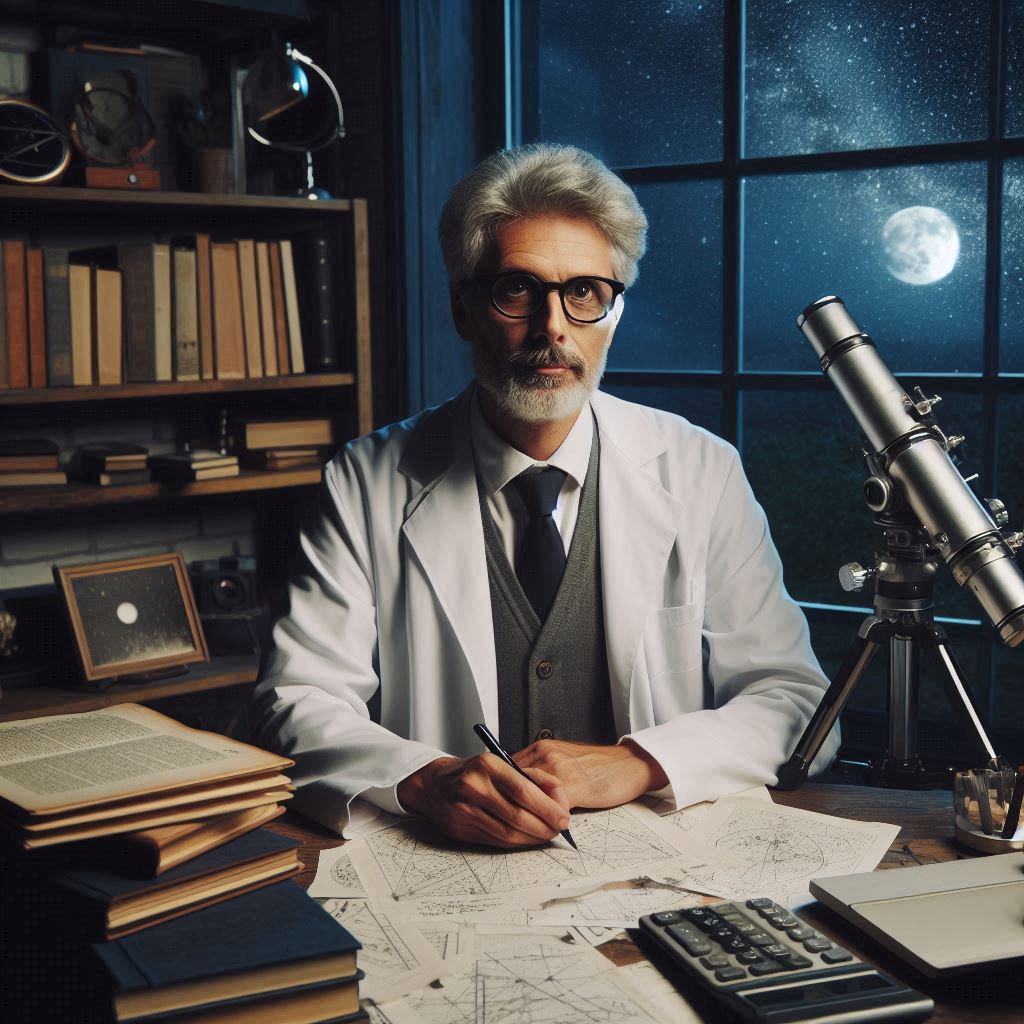Introduction
Astronomers study celestial objects like stars, planets, galaxies, and phenomena beyond Earth’s atmosphere.
They analyze data from telescopes, satellites, and space missions.
Their work helps expand our understanding of the universe and its origins.
Astronomers focus on observing and interpreting data to answer fundamental questions about space.
Astronomy is vital because it allows us to explore the universe and our place in it.
It also drives technological advancements used in other fields.
For example, imaging techniques developed for space are now applied in medical equipment.
By studying celestial bodies, astronomers also help predict cosmic events, like solar flares, which can affect Earth‘s satellites and communication systems.
Understanding the universe‘s mysteries helps us explore questions about life beyond Earth, the nature of black holes, and the origins of the cosmos.
These answers could potentially reshape humanity‘s future.
Through their work, astronomers contribute to science and technology that may impact future space exploration and even energy solutions.
A day in the life of an astronomer varies depending on their specialization.
Some spend time observing the night sky at observatories, while others analyze data from computers.
Astronomers collaborate with fellow scientists to develop theories, publish research, and present findings at conferences.
They might also teach university courses or engage in public outreach to promote space science.
Education and Training
Educational Requirements to Become an Astronomer
To become an astronomer, you need a solid educational background in math, physics, and computer science.
A bachelor’s degree in astronomy or physics serves as the foundation.
During undergraduate studies, students learn the basics of the universe, such as planetary systems and celestial mechanics.
They also gain critical thinking skills and a strong understanding of scientific methods.
Importance of Pursuing Higher Education in Astronomy
Higher education is essential for pursuing a career as an astronomer.
After earning a bachelor‘s degree, aspiring astronomers must pursue a master’s degree and then a Ph.D.
Graduate programs focus on advanced topics like astrophysics, cosmology, and observational techniques.
These programs also offer the opportunity to conduct original research under the supervision of experienced professors.
Specialized Training and Skills Needed for This Career
Specialized training plays a key role in the development of an astronomer‘s career.
Many astronomers become experts in observational astronomy, where they use telescopes to gather data on celestial objects.
Others may focus on theoretical astronomy, using advanced mathematics and computer models to simulate cosmic events.
Both paths require deep analytical skills and strong problem-solving abilities.
Learning to operate advanced astronomical instruments is critical for observational astronomers.
They must understand how to use telescopes, spectrographs, and detectors to collect precise data.
Training in data analysis tools and software, like Python and MATLAB, also equips astronomers to interpret large data sets.
Computational skills are especially important for astronomers working with space missions or conducting simulations.
A solid understanding of physics is vital for any astronomer.
Knowledge of how gravity, electromagnetism, and thermodynamics influence celestial bodies helps astronomers interpret their observations.
Physics principles also allow astronomers to make predictions about cosmic phenomena, like black holes or star formation.
Collaboration is a major part of an astronomer’s career.
Many astronomers work with international teams to conduct research or run large space observatories.
Effective communication and teamwork skills are necessary for managing joint projects and publishing research findings.
In addition to scientific skills, astronomers must excel in writing and presenting research.
Most astronomers publish their findings in scientific journals and present at conferences.
Developing strong technical writing skills during your education is essential for career success.
Staying Current with Technological Advancements
Astronomers also need to stay updated on technological advancements.
Astronomy is a rapidly changing field, with new discoveries and instruments emerging regularly.
Lifelong learning and attending professional workshops help astronomers stay on the cutting edge of their field.
Overall, education and training play a fundamental role in preparing for a career in astronomy.
A strong academic foundation, specialized skills, and ongoing professional development are key to success in this field.
Research and Observation
Conducting Research on Celestial Bodies and Phenomena
Astronomers dedicate much of their day to research and observation, focusing on celestial bodies and phenomena.
They explore the mysteries of the universe through rigorous study, often using powerful tools like telescopes to aid their work.
This hands-on approach enables them to observe stars, planets, galaxies, and other cosmic entities in great detail.
By capturing data from these observations, astronomers can better understand the origins and behavior of the universe.
In their research, astronomers often investigate questions about the life cycle of stars, the existence of exoplanets, and the properties of black holes.
These inquiries involve hours of data collection and analysis, helping astronomers unlock hidden secrets in the cosmos.
Every observation contributes to a broader understanding of space and may lead to groundbreaking discoveries.
Using Telescopes and Other Equipment for Observations
Astronomers rely on sophisticated telescopes to observe celestial bodies.
They might use ground-based telescopes or space telescopes like the Hubble Space Telescope to capture images of distant galaxies or planetary systems.
The equipment used varies based on the research focus, but the goal is always the same: to gather clear, precise data on astronomical phenomena.
In addition to telescopes, astronomers also use specialized tools such as spectrometers, which help determine the composition of celestial objects.
By analyzing light from stars or planets, they can infer information about the object’s chemical makeup, temperature, and movement.
This vital data assists in piecing together the complex puzzle of space.
Analyzing Data and Making Interpretations Based on Findings
Once astronomers gather their data, the next step involves careful analysis.
They sift through the data to find patterns or anomalies that could reveal new information.
Astronomers often spend hours analyzing light curves, images, and other data points, looking for any sign of an event like a supernova or a planet transit.
Interpreting the data is an essential part of their job.
It requires expertise and attention to detail, as every piece of information can lead to a new discovery.
Astronomers interpret the data based on known scientific principles, but sometimes they encounter phenomena that defy current understanding.
These moments push the boundaries of science and lead to new theories.
Astronomers also collaborate with other researchers to interpret their findings.
They discuss their results with colleagues and may publish their conclusions in scientific journals.
Sharing their discoveries helps the scientific community progress, sparking further research and innovation.
Read: Essential Skills and Tools for Modern Chemists in America
Data Analysis and Interpretation
Processing data collected from observations
Astronomers spend much of their time analyzing data collected from observations.
They gather information from telescopes, satellites, and other instruments.
After collecting this data, astronomers process it using specialized software and tools.
This step is crucial in transforming raw data into meaningful insights about the universe.
Using mathematical models and computer simulations
Mathematical models are essential for analyzing astronomical data.
Astronomers use these models to simulate celestial phenomena, helping them understand complex processes.
These models allow scientists to predict the behavior of planets, stars, and galaxies based on observed patterns.
Computer simulations play a critical role in modern astronomy.
Astronomers rely on them to recreate events like star formation or galaxy collisions.
These simulations offer valuable insights into how the universe evolves over time.
Without simulations, many of these cosmic processes would remain impossible to study directly.
Making connections between data to understand the universe
The ability to make connections between different sets of data is a key skill for astronomers.
They must compare observations from various instruments to gain a complete understanding of celestial objects.
For example, astronomers may combine optical, radio, and infrared data to study a distant galaxy in detail.
Through data interpretation, astronomers uncover hidden details about the universe.
By connecting different pieces of information, they can determine the composition of stars, the movement of galaxies, and even the existence of new planets.
Every piece of data provides a small clue to a much larger cosmic puzzle.
Astronomers also use statistical analysis to interpret data.
This helps them identify trends and patterns in their observations.
By applying statistical methods, astronomers can distinguish between random noise and significant findings.
These tools allow them to confidently draw conclusions from vast amounts of data.
Astronomers collaborate with other scientists to ensure accurate data analysis.
They often work in teams, sharing insights and combining their expertise to interpret complex data.
Collaborations allow them to test hypotheses and validate findings before publishing their results.
The process of analyzing and interpreting data can take months or even years.
Astronomers must be patient and thorough, as one mistake could lead to incorrect conclusions.
Despite the challenges, the reward comes in the form of new discoveries and a deeper understanding of the cosmos.
Astronomers continuously refine their methods of data analysis.
As technology advances, new tools and techniques emerge, allowing them to study the universe with greater precision.
These advancements push the boundaries of human knowledge and open up new avenues for exploration.
In short, data analysis and interpretation are central to an astronomer‘s work.
By processing observations, using models and simulations, and making critical connections, astronomers unlock the mysteries of the universe.
Read: The Role of Chemists in US Environmental and Sustainability Efforts
Collaboration and Communication
Working with Other Astronomers and Researchers
Astronomers constantly collaborate with other researchers to enhance their work.
They rely on partnerships with fellow astronomers and scientific experts to gather data and share insights.
This collaboration helps them cross-check findings, validate observations, and draw accurate conclusions.
Astronomers often work in teams to operate telescopes, analyze data, and develop theories.
These teams may include experts in areas like physics, computer science, or engineering.
By working together, they can tackle complex problems and develop innovative solutions to advance scientific knowledge.
Communicating Findings Through Papers, Presentations, and Conferences
In addition to collaborating within astronomy, astronomers communicate their discoveries to the broader scientific community.
One primary method of sharing their findings is through scientific papers.
These papers are peer-reviewed to ensure accuracy and credibility.
Astronomers write detailed reports that explain their methods, observations, and conclusions.
These papers are published in scientific journals, making their findings accessible to researchers worldwide.
Presentations are another key aspect of communication in astronomy.
Astronomers present their research at conferences and seminars, where they can engage with other scientists.
This platform allows them to explain their discoveries and receive feedback from peers.
Presentations also offer opportunities for networking, fostering connections with other researchers in the field.
Astronomers often participate in international conferences, where they exchange ideas and discuss advancements in the field.
These events are essential for staying updated on the latest developments in astronomy and related disciplines.
By attending conferences, astronomers can keep their knowledge current and contribute to the global conversation on space exploration.
Collaboration with Other Scientific Disciplines for a Comprehensive Approach
Collaboration also extends beyond astronomy, as astronomers frequently work with scientists from other disciplines.
Physics, for example, plays a crucial role in understanding celestial phenomena.
Astronomers often collaborate with physicists to study black holes, dark matter, and the fundamental forces of the universe.
These partnerships help build a more comprehensive understanding of the cosmos.
Astronomers may also collaborate with engineers when developing new technology, such as telescopes or spacecraft.
These innovations enable astronomers to observe distant objects and gather critical data.
By working with engineers, astronomers can ensure that their instruments are designed to meet the needs of their research.
In recent years, data scientists have become valuable partners in astronomy.
As astronomical data grows in volume and complexity, data scientists help analyze and interpret this information.
Their expertise in algorithms and computing allows astronomers to sift through vast datasets efficiently.
In a nutshell, collaboration and communication are essential to an astronomer‘s work.
Through teamwork and sharing their findings, astronomers push the boundaries of human knowledge and contribute to our understanding of the universe.
Read: Day in the Life: An Environmental Scientist‘s Typical Day

See Related Content: How to Become a Meteorologist: Education and Skills
Problem Solving and Innovation
Addressing Challenges in Understanding the Universe
Astronomers face many challenges in their quest to understand the universe.
They explore vast distances, often beyond our current technological reach.
These challenges include deciphering complex cosmic phenomena and unraveling the mysteries of dark matter and dark energy.
Astronomers rely on advanced instruments to collect data from celestial bodies.
They use telescopes, satellites, and space probes to gather critical information.
However, interpreting this data can be challenging due to its complexity.
Developing New Theories and Hypotheses
Developing new theories and hypotheses is essential in astronomy.
Astronomers analyze collected data to form testable predictions.
They often draw from physics, mathematics, and chemistry to create these theories.
For instance, the discovery of exoplanets has led to new ideas about planetary formation and habitability.
Researchers propose theories to explain unusual astronomical events, such as gamma-ray bursts and black hole behavior.
This constant cycle of observation and theory helps refine our understanding of the cosmos.
Transform Your Career Today
Unlock a personalized career strategy that drives real results. Get tailored advice and a roadmap designed just for you.
Start NowPushing the Boundaries of Current Knowledge Through Innovative Research
Pushing the boundaries of current knowledge requires innovative research.
Astronomers frequently collaborate with scientists from other fields, like astrophysics and cosmology.
This interdisciplinary approach fosters the exchange of ideas and methodologies.
For example, some astronomers use computer simulations to model cosmic events.
These simulations provide insights into galaxy formation, star evolution, and the dynamics of gravitational interactions.
By applying advanced computational techniques, researchers can test their hypotheses against simulated outcomes.
Moreover, astronomers actively engage in international collaborations.
Projects like the Event Horizon Telescope involve teams from multiple countries working together.
This global effort aimed to capture the first image of a black hole‘s event horizon.
Such collaborations help share resources, expertise, and funding.
They enable astronomers to tackle problems that single institutions might find daunting.
Fieldwork also plays a vital role in addressing cosmic challenges.
Astronomers often participate in expeditions to remote locations.
They gather data from areas with minimal light pollution, ensuring clearer observations.
These field campaigns enhance their understanding of celestial events and phenomena.
For instance, studying meteor showers requires precise timing and location.
The ongoing pursuit of knowledge drives astronomers to challenge existing paradigms.
They continuously question the status quo and explore new frontiers.
Each discovery leads to new questions, expanding our understanding of the universe.
By addressing challenges, developing theories, and pushing boundaries, astronomers significantly advance human knowledge.
In fact, astronomers tackle the complexities of the universe through dedicated research.
They develop innovative theories, collaborate globally, and engage in fieldwork.
Their relentless pursuit of knowledge ultimately enriches our understanding of the cosmos.
The work of astronomers inspires curiosity about the universe and our place within it.
Read: The Impact of Technology on the Chemist Profession in the US
Work Environment
A Typical Day in the Life of an Astronomer
Astronomers work in diverse environments, from observatories to laboratories.
They often spend time at research institutions and universities.
Their work can also take them to remote sites for night observations.
A typical day varies greatly based on ongoing projects and research focuses.
Many astronomers start their day with data analysis.
They examine data collected from telescopes and satellites.
This involves using advanced software to interpret complex datasets.
Astronomers look for patterns and anomalies that might indicate new findings.
They also collaborate with other scientists to discuss their analyses.
This teamwork fosters creativity and innovation in their research.
Afternoons often include meetings and discussions with colleagues.
Astronomers share ideas and brainstorm on future projects.
They may also review research papers and prepare for presentations.
Writing articles for scientific journals is a significant part of their job.
Astronomers must communicate their findings clearly and effectively.
Varied Tasks Such as Observation, Data Analysis, and Theoretical Work
In addition to data analysis, astronomers dedicate time to theoretical work.
They develop models to predict celestial phenomena.
This theoretical groundwork helps them design future observations.
It also aids in understanding the implications of their findings.
Some astronomers focus on developing new technologies for telescopes.
They strive to improve observational techniques and equipment.
Night observations are a vital aspect of an astronomer’s work.
These sessions typically begin after sunset and can last for several hours.
During this time, astronomers use telescopes to observe celestial objects.
They often conduct scheduled observations based on their research goals.
Night work demands flexibility, as conditions can change quickly.
Cloud cover or technical issues may delay or alter plans.
Many astronomers enjoy the solitude of nighttime observations.
The quiet environment allows for deep concentration on their work.
They may spend hours capturing images of distant galaxies or analyzing stellar light.
This hands-on work is rewarding and critical for advancing astronomical knowledge.
Flexibility in Work Hours Due to Night Observations
Despite the demanding hours, many astronomers find their work fulfilling.
The thrill of discovery keeps them motivated.
They contribute to our understanding of the universe and its mysteries.
The unique combination of observation, data analysis, and theory excites many in the field.
In essence, an astronomer‘s day involves varied tasks and flexible hours.
From data analysis to night observations, they engage deeply with the cosmos.
Their work environment fosters collaboration, creativity, and exploration.
Each day brings new challenges and opportunities for discovery.
Astronomers play a vital role in uncovering the secrets of the universe.
Conclusion
Astronomers play a vital role in expanding our understanding of the universe.
Their responsibilities encompass a wide range of tasks.
They conduct observations, analyze data, and develop theoretical models.
Through their work, they contribute to groundbreaking discoveries and advancements in science.
The tasks of astronomers vary greatly, depending on their specialization.
Observational astronomers focus on gathering data from telescopes.
They monitor celestial objects and phenomena, seeking to understand their nature and behavior.
Theoretical astronomers, on the other hand, create models to explain observations.
They use mathematics and physics to simulate cosmic processes.
Astronomers also collaborate with engineers and other scientists.
This teamwork helps develop advanced technologies and instruments.
These innovations improve our observational capabilities and deepen our understanding of the cosmos.
The discoveries made by astronomers often lead to new scientific questions and areas of research.
Their work continuously pushes the boundaries of what we know.
The role of astronomers extends beyond research.
They engage in public outreach, sharing their findings with the world.
By communicating complex ideas, they inspire interest in science and the universe.
Their efforts help cultivate the next generation of scientists and explorers.
They play a crucial part in shaping public perception of science.
[E-Books for Sale]
The Big Book of 500 High-Paying Jobs in America: Unlock Your Earning Potential
$19.99 • 500 High-Paying Jobs • 330 pages
Explore 500 high-paying jobs in America and learn how to boost your career, earn more, and achieve success!
See All 500 High-Paying Jobs of this E-Book
1001 Professions Without a Degree: High-Paying American Jobs You Can Start Now
$19.99 • 1001 Professions Without a Degree • 174 pages
Discover 1001 high-paying jobs without a degree! Unlock career tips, skills, and success strategies for just $19.99!




